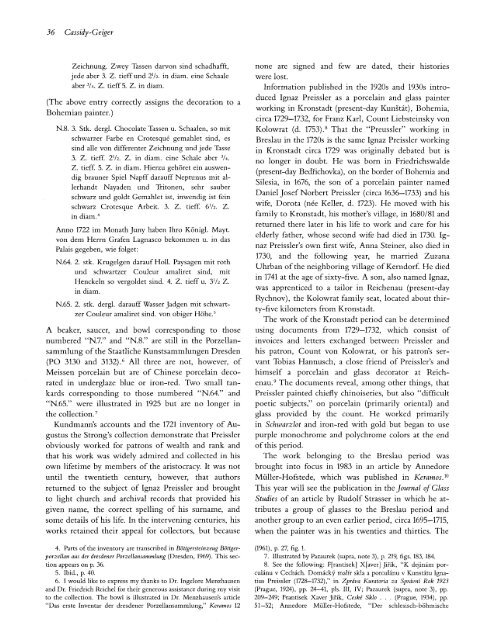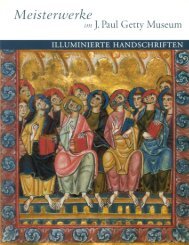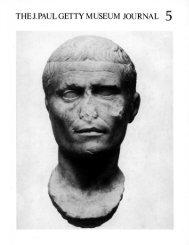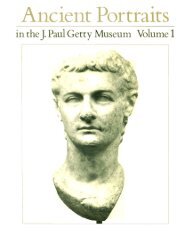The J. Paul Getty Museum Journal Volume 15 1987
The J. Paul Getty Museum Journal Volume 15 1987
The J. Paul Getty Museum Journal Volume 15 1987
You also want an ePaper? Increase the reach of your titles
YUMPU automatically turns print PDFs into web optimized ePapers that Google loves.
36 Cassidy-GeigerZeichnung. Zwey Tassen darvon sind schadhafft,jede aber 3. Z. tieff und 272. in diam. eine Schaaleaber 3 A. Z. tieff 5. Z. in diam.(<strong>The</strong> above entry correctly assigns the decoration to aBohemian painter.)N.8. 3. Stk. dergl. Chocolate Tassen u. Schaalen, so mitschwarzer Farbe en Crotesque gemahlet sind, essind alle von differenter Zeichnung und jede Tasse3. Z. tieff. 272. Z. in diam. eine Schale aber 74.Z. tieff. 5. Z. in diam. Hierzu gehöret ein auswendigbrauner Spiel Napff darauff Neptunus mit allerhandtNayaden und Tritonen, sehr sauberschwarz und goldt Gemahlet ist, inwendig ist feinschwarz Crotesque Arbeit. 3. Z. tieff. 672. Z.in diam. 4Anno 1722 im Monath Juny haben Ihro Königl. Mayt.von dem Herrn Grafen Lagnasco bekommen u. in dasPalais gegeben, wie folget:N.64. 2. stk. Krugeigen darauf Holl. Paysagen mit rothund schwartzer Couleur amaliret sind, mitHenckeln so vergoldet sind. 4. Z. tieff u. 372 Z.in diam.N.65. 2. stk. dergl. darauff Wasser Jadgen mit schwartzerCouleur amaliret sind, von obiger Höhe. 5A beaker, saucer, and bowl corresponding to thosenumbered "N.7." and "N.8." are still in the Porzellansammlungof the Staatliche Kunstsammlungen Dresden(PO 3130 and 3132). 6All three are not, however, ofMeissen porcelain but are of Chinese porcelain decoratedin underglaze blue or iron-red. Two small tankardscorresponding to those numbered "N.64." and"N.65." were illustrated in 1925 but are no longer inthe collection. 7Kundmanns accounts and the 1721 inventory of Augustusthe Strong's collection demonstrate that Preisslerobviously worked for patrons of wealth and rank andthat his work was widely admired and collected in hisown lifetime by members of the aristocracy. It was notuntil the twentieth century, however, that authorsreturned to the subject of Ignaz Preissler and broughtto light church and archival records that provided hisgiven name, the correct spelling of his surname, andsome details of his life. In the intervening centuries, hisworks retained their appeal for collectors, but becausenone are signed and few are dated, their historieswere lost.Information published in the 1920s and 1930s introducedIgnaz Preissler as a porcelain and glass painterworking in Kronstadt (present-day Kunstät), Bohemia,circa 1729—1732, for Franz Karl, Count Liebsteinsky vonKolowrat (d. 1753). 8That the "Preussler" working inBreslau in the 1720s is the same Ignaz Preissler workingin Kronstadt circa 1729 was originally debated but isno longer in doubt. He was born in Friedrichswalde(present-day Bedrichovka), on the border of Bohemia andSilesia, in 1676, the son of a porcelain painter namedDaniel Josef Norbert Preissler (circa 1636—1733) and hiswife, Dorota (nee Keller, d. 1723). He moved with hisfamily to Kronstadt, his mother's village, in 1680/81 andreturned there later in his life to work and care for hiselderly father, whose second wife had died in 1730. IgnazPreissler's own first wife, Anna Steiner, also died in1730, and the following year, he married ZuzanaUhrban of the neighboring village of Kerndorf. He diedin 1741 at the age of sixty-five. A son, also named Ignaz,was apprenticed to a tailor in Reichenau (present-dayRychnov), the Kolowrat family seat, located about thirty-fivekilometers from Kronstadt.<strong>The</strong> work of the Kronstadt period can be determinedusing documents from 1729—1732, which consist ofinvoices and letters exchanged between Preissler andhis patron, Count von Kolowrat, or his patrons servantTobias Hannusch, a close friend of Preissler's andhimself a porcelain and glass decorator at Reichenau.9<strong>The</strong> documents reveal, among other things, thatPreissler painted chiefly chinoiseries, but also "difficultpoetic subjects," on porcelain (primarily oriental) andglass provided by the count. He worked primarilyin Schwarzlot and iron-red with gold but began to usepurple monochrome and polychrome colors at the endof this period.<strong>The</strong> work belonging to the Breslau period wasbrought into focus in 1983 in an article by AnnedoreMüller-Hofstede, which was published in Keramos. 10This year will see the publication in the <strong>Journal</strong> of GlassStudies of an article by Rudolf Strasser in which he attributesa group of glasses to the Breslau period andanother group to an even earlier period, circa 1695—17<strong>15</strong>,when the painter was in his twenties and thirties. <strong>The</strong>4. Parts of the inventory are transcribed in Böttgersteinzeug Böttgerporzellanaus der dresdener PorZellansammlung (Dresden, 1969). This sectionappears on p. 36.5. Ibid., p. 40.6. I would like to express my thanks to Dr. Ingelore Menzhausenand Dr. Friedrich Reichel for their generous assistance during my visitto the collection. <strong>The</strong> bowl is illustrated in Dr. Menzhausen's article"Das erste Inventar der dresdener Porzellansammlung," Keramos 12(1961), p. 27, fig. 1.7. Illustrated by Pazaurek (supra, note 3), p. 219, figs. 183, 184.8. See the following: F[rantisek] X[aver] Jink, "K dejinam porculänuv Cechäch. Domäcky malir skia a porculänu v Kunstätu IgnatiusPreissler (1728—1732)," in Zprdva Kuratoria za Spravni Rok 1923(Prague, 1924), pp. 24-41, pis. III, IV; Pazaurek (supra, note 3), pp.209-249; Frantisek Xaver Jifik, Ceske Sklo . . . (Prague, 1934), pp.51—52; Annedore Müller-Hofstede, "Der schlesisch-böhmische








